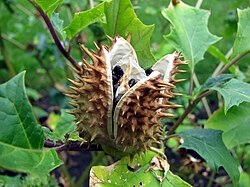Talk:Datura stramonium (botany)
This page has not been fully approved by the PsychonautWiki administrators. It may contain incorrect information, particularly with respect to dosage, duration, subjective effects, toxicity and other risks. It may also not meet PW style and grammar standards. |
This article is a stub. As such, it may contain incomplete or wrong information. You can help by expanding it. |

Datura is extremely dangerous and can directly cause severe injury or death.
Datura is highly unpredictable and its use is strongly linked to psychosis, severe injury, and death. Please see this section for more details.
| Datura stramonium (botany) | |
|---|---|
|
Ripened fruit of D. stramonium |
|
| Taxonomical nomenclature | |
| Kingdom | Plantae |
| Unranked | Angiosperms |
| Unranked | Eudicots |
| Unranked | Asterids |
| Order | Solanales |
| Family | Solanaceae |
| Genus | Datura |
| Species | D. stramonium |
| Common nomenclature | |
| Common names | Devil's trumpets, Angel's trumpets, Moonflowers, Jimsonweed, Devil's weed, Hell's bells, Thorn-apple |
| Constituents | |
| Active constituents | Tropane alkaloids |
Datura stramonium, is a plant in the Datura genus and the Solanaceae family (nightshade).
Entheogen
Algonquin, Navajo, Cherokee, Luiseño and the indigenous peoples of Marie-Galante used this plant in sacred ceremonies for its hallucinogenic properties.[1][2][3] It has also been used by Sadhus of India, and the Táltos of the Magyar (Hungary).
Common names
External links
References
- ↑ Biaggioni, Italo et al. (2011). Primer on the Autonomic Nervous System. Academic Press. p. 77. ISBN 978-0-12-386525-0.
- ↑ Pennachio, Marcello et al. (2010). Uses and Abuses of Plant-Derived Smoke: Its Ethnobotany As Hallucinogen, Perfume, Incense, and Medicine. Oxford University Press. pp. 82–83. ISBN 978-0-19-537001-0.
- ↑ Davis, Wade (1997). The Serpent and the Rainbow: a Harvard scientist's astonishing journey into the secret societies of Haitian voodoo, zombis and magic. Simon & Schuster. ISBN 978-0-684-83929-5.
